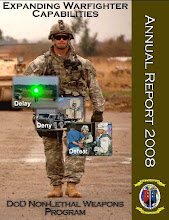 America's Nuclear Reactors are perhaps some of the most critical infrastructure in America, and also some of the most poorly guarded...as example, the NEI was successful in convincing the NRC that Bullet Resistence Glass was fine when weighed with what it would cost the Licensees to upgrade their guard towers! (About $10 million per reactor site on a one time investment basis.)
America's Nuclear Reactors are perhaps some of the most critical infrastructure in America, and also some of the most poorly guarded...as example, the NEI was successful in convincing the NRC that Bullet Resistence Glass was fine when weighed with what it would cost the Licensees to upgrade their guard towers! (About $10 million per reactor site on a one time investment basis.)That might sound like a lot of money, the industry position reasonable until you take a look at the DOD and their Directed Energy Directorate located at the Phillips Research Site, Kirtland Air Force Base, New Mexico. The Directorate has a workforce of more than 600 people, an annual budget exceeding $130 million, and 670,000 square feet of working space. What do they do? Look for ways to blind large groups of protesters with pulse weapons while they turn your brains into egg salad. (Right now, they are looking to control the lazer pulses enough that they do not do permanent eye damage. Take Microwave oven doors to your next Anti Nuclear sit in to make a group shield with.)
The Advanced Optics & Imaging Division develops techniques and technologies to improve optical systems, and then transition those systems to war-fighting commands. The Division also is working on systems that will accurately place a beam of laser light on a target such as an attacking missile. Much of this research is in support of the Air Force's Airborne Laser program.
The High-Power Microwave Division is the Air Force's center of excellence for high-power microwave technologies, managing all research and development in that area. This includes high-power microwave hardware and systems, as well as protection against an aggressor's microwave systems.
The Laser Division is the Department of Defense's center of expertise for the development of lasers and for getting those technologies to U.S. military forces. Included are semiconductor, gas, chemical, and solid-state lasers.
The Optical Surveillance Division provides research and development for leading-edge space capabilities to enhance the United States' space mission.
The Starfire Optical Range Division operates a facility that includes a 3.5-meter telescope, one of the largest in the world able to image satellites passing quickly overhead. The facility also uses lasers and adaptive optics as part of its research for obtaining high-resolution images of objects in space.
The Program Integration Division assesses potential applications and effects of systems incorporating directed energy technologies. The Division also manages the strategic development of the Directed Energy Directorate.






























No comments:
Post a Comment